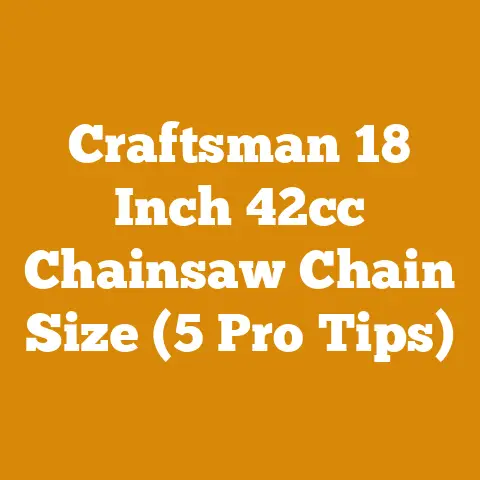Chainsaw Chain for Milling (Expert Guide to Ripping Blades)
Ever dreamed of turning fallen giants into stunning lumber right in your own backyard? Of unlocking the hidden beauty within a rough log, revealing the grain and character that only nature can create? If so, you’ve come to the right place. This guide is your deep dive into the world of chainsaw milling, specifically focusing on the heart of the operation: the chainsaw chain for milling, also known as a ripping blade.
Chainsaw Milling: From Forest Floor to Finished Lumber
The global wood processing and logging industry is a behemoth, estimated to be worth hundreds of billions of dollars annually. However, nestled within this massive industry are countless smaller players: independent loggers, hobbyist woodworkers, and small-scale sawmills, all striving to make the most of available timber resources. The demand for custom lumber, unique wood pieces, and sustainable forestry practices is growing, creating a niche for chainsaw milling.
Chainsaw milling allows you to take control of the entire process, from felling the tree to crafting the final product. It’s a cost-effective way to produce lumber if you have access to timber and the necessary tools. It also lets you mill wood that might be too large or difficult to transport to a traditional sawmill. But, like any specialized craft, success hinges on understanding the nuances of the tools, techniques, and materials involved.
What is Chainsaw Milling?
Simply put, chainsaw milling is the process of using a chainsaw, in conjunction with a specialized attachment called a chainsaw mill, to cut logs into lumber. Instead of cutting across the grain like you would when bucking firewood, you’re cutting along the grain, revealing the wood’s internal structure and creating boards or slabs.
Why Choose Chainsaw Milling?
- Accessibility: Chainsaw milling opens up opportunities for individuals with limited space or access to traditional sawmills.
- Cost-Effectiveness: If you have access to timber, chainsaw milling can be significantly cheaper than purchasing lumber.
- Customization: You have complete control over the dimensions and quality of the lumber you produce.
- Sustainability: You can utilize fallen trees or salvage timber that would otherwise go to waste.
- Fulfillment: There’s a deep satisfaction in transforming a raw log into a beautiful, functional piece of lumber.
The Heart of the Operation: Chainsaw Chains for Milling (Ripping Blades)
While your chainsaw is the engine, and the mill is the framework, the chain is the blade doing the actual cutting. Choosing the right chain for milling, specifically a ripping blade, is absolutely crucial for efficient and accurate lumber production. Using a standard crosscut chain for milling is like trying to cut a steak with a butter knife – possible, but slow, inefficient, and ultimately frustrating.
What Makes a Ripping Chain Different?
The key difference lies in the grind angle of the cutting teeth. A standard crosscut chain is designed to sever wood fibers across the grain. Its teeth have a more aggressive angle (typically 25-35 degrees) to quickly slice through the wood. A ripping chain, on the other hand, is designed to cut along the grain, effectively shaving the wood away. This requires a much shallower grind angle, typically around 10 degrees.
Think of it like this: A crosscut chain is like a series of small axes chopping at the wood, while a ripping chain is like a plane smoothing the surface.
- Crosscut Chain: Aggressive angle, fast cutting across the grain, prone to rough cuts and excessive vibration when milling.
- Ripping Chain: Shallow angle, smooth cutting along the grain, produces cleaner cuts, less vibration, and greater efficiency when milling.
Why Use a Ripping Chain for Milling?
- Cleaner Cuts: The shallower angle of a ripping chain produces a smoother, more consistent surface on the lumber. This reduces the amount of planing and sanding required later on.
- Increased Efficiency: Ripping chains are designed to cut along the grain with less resistance, allowing you to mill more lumber with less effort.
- Reduced Vibration: The smoother cutting action of a ripping chain reduces vibration, making the milling process more comfortable and less fatiguing.
- Longer Chain Life: Because ripping chains are designed for a specific task, they tend to last longer than crosscut chains used for milling.
- Improved Accuracy: The smoother cutting action of a ripping chain helps you maintain a more consistent depth of cut, leading to more accurate lumber dimensions.
Common Misconceptions about Ripping Chains
- “Ripping chains are only for softwoods.” While they excel at cutting softwoods like pine and cedar, ripping chains can also be used on hardwoods, although they may require more frequent sharpening.
- “Ripping chains are slower than crosscut chains.” While they may appear slower at first, the cleaner cuts and reduced effort ultimately result in faster overall lumber production.
- “Any chain can be sharpened to a ripping angle.” While technically possible, it’s difficult to achieve the precise and consistent angle required for optimal ripping performance. It’s best to purchase a chain specifically designed for ripping.
Selecting the Right Ripping Chain: A Detailed Guide
Choosing the right ripping chain involves considering several factors, including the size and power of your chainsaw, the type of wood you’ll be milling, and your personal preferences.
1. Chain Pitch
The pitch of a chainsaw chain refers to the distance between three consecutive rivets, divided by two. It’s a crucial measurement that determines whether the chain will fit your chainsaw’s drive sprocket and bar. Common chain pitches include:
- 1/4 inch: Typically found on smaller, low-power chainsaws. Not suitable for milling.
- .325 inch: A common pitch for mid-sized chainsaws. Can be used for milling smaller logs.
- 3/8 inch: The most common pitch for chainsaws used in milling. Offers a good balance of cutting speed and durability.
- .404 inch: Typically found on larger, more powerful chainsaws used for milling large logs.
How to Determine Your Chain Pitch:
- Check your chainsaw’s manual: The manual will specify the recommended chain pitch.
- Look at the drive sprocket: The drive sprocket will often have the chain pitch stamped on it.
- Measure the chain: If you’re unsure, you can measure the distance between three consecutive rivets and divide by two.
Important Note: Using the wrong chain pitch can damage your chainsaw and potentially cause serious injury.
2. Chain Gauge
The gauge of a chainsaw chain refers to the thickness of the drive links that fit into the groove of the chainsaw bar. It’s another crucial measurement that must match your chainsaw’s bar. Common chain gauges include:
- .043 inch (1.1 mm): Typically found on smaller, low-power chainsaws. Not suitable for milling.
- .050 inch (1.3 mm): A common gauge for mid-sized chainsaws. Can be used for milling smaller logs.
- .058 inch (1.5 mm): A common gauge for chainsaws used in milling. Offers a good balance of cutting speed and durability.
- .063 inch (1.6 mm): Typically found on larger, more powerful chainsaws used for milling large logs.
How to Determine Your Chain Gauge:
- Check your chainsaw’s manual: The manual will specify the recommended chain gauge.
- Look at the chainsaw bar: The bar will often have the chain gauge stamped on it.
- Use a gauge measurement tool: You can purchase a specialized tool to measure the chain gauge.
Important Note: Using the wrong chain gauge can cause the chain to bind in the bar, leading to overheating and potential damage.
3. Number of Drive Links
The number of drive links is the total number of links that fit into the groove of the chainsaw bar. This number will vary depending on the length of your bar.
How to Determine the Number of Drive Links:
- Check your chainsaw’s manual: The manual may specify the number of drive links for different bar lengths.
- Count the drive links on your existing chain: If you’re replacing an existing chain, simply count the number of drive links.
- Use a chain selector tool: Many online retailers offer chain selector tools that can help you determine the correct number of drive links based on your chainsaw model and bar length.
Important Note: Using a chain with the incorrect number of drive links will prevent it from fitting properly on the bar.
4. Chain Type and Tooth Design
Several different types of ripping chains are available, each with its own unique tooth design. Some common options include:
- Full Chisel Ripping Chains: These chains have square-cornered teeth that offer aggressive cutting and are best suited for softwoods. They require more frequent sharpening.
- Semi-Chisel Ripping Chains: These chains have rounded-cornered teeth that are more durable and forgiving than full chisel chains. They are a good choice for hardwoods and dirty wood.
- Skip Tooth Ripping Chains: These chains have fewer teeth than standard chains, which can help to reduce vibration and improve chip clearance when milling large logs.
Choosing the Right Tooth Design:
- Softwoods: Full chisel ripping chains offer the best cutting performance.
- Hardwoods: Semi-chisel ripping chains are more durable and less prone to damage.
- Large Logs: Skip tooth ripping chains can help to reduce vibration and improve chip clearance.
5. Chain Quality and Brand
The quality of the chain can significantly impact its performance and lifespan. Investing in a high-quality chain from a reputable brand is generally worth the extra cost. Some popular brands of ripping chains include:
- Oregon: A well-known and respected brand that offers a wide range of chainsaw chains, including ripping chains.
- Stihl: Another leading brand that produces high-quality chains and chainsaws.
- Husqvarna: A popular brand that offers a variety of chainsaw chains and accessories.
- Granberg: A brand specializing in chainsaw milling equipment, including ripping chains.
Tips for Choosing a Chain Brand:
- Read online reviews: See what other users have to say about different chain brands and models.
- Consult with experienced millers: Ask for recommendations from experienced chainsaw millers.
- Consider your budget: While it’s important to invest in a high-quality chain, you don’t necessarily need to buy the most expensive option.
Sharpening Ripping Chains: Maintaining Peak Performance
A sharp chain is essential for efficient and accurate chainsaw milling. Dull chains require more effort to cut, produce rougher cuts, and can even damage your chainsaw. Sharpening ripping chains requires a slightly different technique than sharpening crosscut chains due to the shallower grind angle.
Tools for Sharpening Ripping Chains
- Chainsaw File: A round file with the correct diameter for your chain pitch.
- File Guide: A specialized tool that helps you maintain the correct filing angle and depth.
- Depth Gauge Tool: A tool for checking and adjusting the depth gauges on the chain.
- Vise: A vise to securely hold the chainsaw bar while sharpening.
Step-by-Step Guide to Sharpening Ripping Chains
- Secure the chainsaw bar in a vise.
- Identify the correct filing angle. For ripping chains, the filing angle is typically around 10 degrees. Refer to your chain manufacturer’s recommendations for the specific angle.
- Place the file guide on the chain. The file guide will help you maintain the correct filing angle and depth.
- File each tooth consistently. Use smooth, even strokes to file each tooth, maintaining the correct angle and depth.
- Check the depth gauges. The depth gauges should be slightly lower than the cutting teeth. Use a depth gauge tool to check and adjust the depth gauges as needed.
- Repeat for all teeth. Sharpen all the teeth on the chain, ensuring that they are all the same length and shape.
Tips for Sharpening Ripping Chains:
- Use a file guide: A file guide is essential for maintaining the correct filing angle and depth.
- File each tooth consistently: Ensure that all the teeth are the same length and shape.
- Check the depth gauges regularly: The depth gauges play a crucial role in the chain’s cutting performance.
- Sharpen frequently: Sharpen your chain regularly to maintain peak performance.
- Consider using a chainsaw sharpener: If you’re not comfortable sharpening chains by hand, you can use a chainsaw sharpener.
When to Replace Your Ripping Chain
Even with proper maintenance, ripping chains will eventually wear out and need to be replaced. Here are some signs that it’s time to replace your chain:
- Teeth are severely worn or damaged.
- Chain stretches excessively.
- Chain no longer holds an edge.
- Cutting performance is significantly reduced.
Chainsaw Milling Techniques: Maximizing Efficiency and Accuracy
Once you have the right chain and a sharp edge, it’s time to focus on milling techniques. Proper technique is just as important as having the right equipment.
Basic Chainsaw Milling Setup
- Chainsaw: A powerful chainsaw with a bar length appropriate for the size of the logs you’ll be milling.
- Chainsaw Mill: A specialized attachment that guides the chainsaw along the log. There are two main types of chainsaw mills:
- Slabbing Mill: Attaches to the chainsaw bar and allows you to cut slabs of lumber.
- Edging Mill: Attaches to the chainsaw bar and allows you to cut boards of consistent thickness.
- Guide Rails: Straight, rigid rails that provide a reference surface for the chainsaw mill.
- Ladders or Scaffolding: To provide a stable platform for working on larger logs.
- Safety Gear: Including a helmet, eye protection, hearing protection, gloves, and chainsaw chaps.
Milling Techniques
- Log Preparation: Prepare the log by removing any bark, dirt, or debris that could damage the chain. Level the log using wedges or shims.
- Setting Up the Guide Rails: Attach the guide rails to the log, ensuring that they are perfectly parallel and level. This is crucial for producing accurate lumber.
- Making the First Cut: The first cut is the most important, as it establishes the reference surface for all subsequent cuts. Take your time and ensure that the cut is straight and consistent.
- Subsequent Cuts: Once the first cut is complete, you can remove the guide rails and use the milled surface as a reference for subsequent cuts. Adjust the chainsaw mill to the desired thickness and make each cut carefully.
- Edging and Trimming: After milling the lumber, you may need to edge and trim the boards to achieve the desired dimensions.
Tips for Efficient and Accurate Milling
- Use a sharp chain: A sharp chain is essential for efficient cutting and accurate lumber dimensions.
- Maintain consistent pressure: Apply consistent pressure to the chainsaw mill to maintain a smooth and even cut.
- Avoid overheating the chainsaw: Allow the chainsaw to cool down periodically to prevent overheating.
- Keep the chain lubricated: Use a high-quality bar and chain oil to keep the chain lubricated and prevent premature wear.
- Work in a well-ventilated area: Chainsaw milling can produce a lot of sawdust, so it’s important to work in a well-ventilated area.
- Take breaks: Chainsaw milling can be physically demanding, so take breaks to avoid fatigue.
Troubleshooting Common Milling Problems
Even with the best equipment and techniques, you may encounter problems during the milling process. Here are some common problems and their solutions:
- Chain Binding: This can be caused by a dull chain, insufficient lubrication, or improper chain tension. Sharpen the chain, lubricate it properly, and adjust the chain tension.
- Wavy Cuts: This can be caused by a dull chain, uneven pressure, or loose guide rails. Sharpen the chain, apply consistent pressure, and ensure that the guide rails are properly secured.
- Overheating: This can be caused by a dull chain, insufficient lubrication, or excessive cutting. Sharpen the chain, lubricate it properly, and allow the chainsaw to cool down periodically.
- Rough Cuts: This can be caused by a dull chain or improper milling technique. Sharpen the chain and practice your milling technique.
Costs and Budgeting Considerations
Chainsaw milling can be a cost-effective way to produce lumber, but it’s important to factor in all the associated costs. These include:
- Chainsaw: A high-quality chainsaw can cost anywhere from \$500 to \$2000 or more.
- Chainsaw Mill: Chainsaw mills can range in price from \$200 to \$1000 or more, depending on the size and features.
- Chainsaw Chains: Ripping chains typically cost between \$30 and \$50 each.
- Guide Rails: Guide rails can be made from wood or metal and can cost anywhere from \$50 to \$200 or more.
- Sharpening Equipment: Sharpening equipment can cost between \$50 and \$200 or more.
- Safety Gear: Safety gear can cost between \$100 and \$300 or more.
- Fuel and Oil: The cost of fuel and oil will vary depending on the amount of milling you do.
Tips for Budgeting:
- Start with the basics: You don’t need to buy the most expensive equipment to get started.
- Shop around for the best prices: Compare prices from different retailers before making a purchase.
- Consider used equipment: You may be able to save money by purchasing used equipment.
- Maintain your equipment: Proper maintenance will help to extend the life of your equipment and reduce repair costs.
Case Study: Milling Black Walnut for a Custom Table
I once had the opportunity to mill a massive black walnut log that had fallen on a friend’s property. The log was over 30 inches in diameter and 12 feet long, and it was too large to transport to a traditional sawmill. Using my chainsaw mill and a ripping chain, I was able to mill the log into beautiful slabs of lumber.
The milling process took several days, but the results were well worth the effort. The slabs were incredibly beautiful, with rich colors and intricate grain patterns. My friend used the slabs to build a stunning custom table that became the centerpiece of his dining room.
This project demonstrated the power and versatility of chainsaw milling. It allowed us to transform a fallen tree into a valuable resource and create a unique piece of furniture that will be treasured for years to come.
- Online Forums: Online forums dedicated to chainsaw milling can provide valuable information and advice.
- YouTube Channels: Many YouTube channels offer tutorials and demonstrations on chainsaw milling techniques.
- Local Sawmills: Local sawmills can provide advice and support for your milling projects.
- Logging Tool Suppliers: Reputable logging tool suppliers can provide high-quality equipment and supplies.
Conclusion: Unlock the Potential of Your Timber
Chainsaw milling is a rewarding and empowering skill that allows you to transform raw timber into beautiful and functional lumber. By understanding the importance of using the right chainsaw chain for milling, specifically a ripping blade, and mastering the proper techniques, you can unlock the potential of your timber resources and create stunning woodworking projects. So, grab your chainsaw, sharpen your chain, and get ready to embark on a journey of creativity and craftsmanship!






